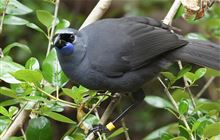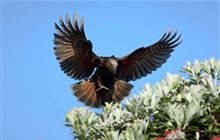Kāpiti Island welcomes kōkako
Archived content: This media release was accurate on the date of publication.
Introduction
The iconic island of Kāpiti has welcomed the first translocation of threatened kōkako in nearly two decades.Date: 07 July 2021
On Monday, 5 July, 11 North Island kōkako were translocated from Pureora Forest to Kāpiti Island. Up to 35 kōkako will be introduced to the island over the next two years to ‘top-up’ the existing 100 pairs, adding diversity to a nationally important population of these rare birds.
This mahi has been made possible through a new partnership between the Department of Conservation (DOC) and Fonterra Brands New Zealand, with the support of local iwi Ngāti Toa, Te Ati Awa ki Whakarongotai and Ngāti Raukawa.
The birds travelled down from Pureora Forest in Waikato with members of Ngāti Rereahu and were gifted in a ceremony held on the island.
Managing Director of Fonterra Brands New Zealand Brett Henshaw says Fonterra is proud to have partnered with DOC to support the population of beautiful kōkako on Kāpiti Island.
“We approached DOC wanting to support a significant conservation project in the Kāpiti region which recognises and appreciates the cultural and community significance of Kāpiti Island.
“Fonterra’s Kāpiti brand has a strong connection with the region so we are delighted to be playing a role reigniting this important translocation programme. Fonterra’s partnership will help to ensure the national kōkako population remain strong and viable into the future.”
Kōkako were first established on Kāpiti Island nearly 30 years ago. However, the very small number released – only 33, with just 11 breeding successfully at the time – meant the population lacked diversity.
Adding to the existing population on Kāpiti will boost the genetic diversity. Being a safe, predator-free offshore location, the island can provide a national insurance population for North Island kōkako should anything happen on the mainland.
Although the national population recently reached a milestone of 2,000 pairs in the wild, predators remain a significant threat to kōkako.
DOC Technical Advisor and member of the Kōkako Recovery Group Tertia Thurley says the partnership enabling this translocation couldn’t come at a better time.
“The kōkako on Kāpiti have been breeding well, especially over the past three to five years when numbers have nearly doubled. But with such a small number of founders, the population is not as robust as it could be.
“By adding bloodlines from key populations not already represented, we can build a really robust safe-haven for the species.”
The top-up transfer to Kāpiti was identified by the recovery group as one of the highest priorities for the species’ national recovery, but the fast-breeding birds on the island would soon fill up available territories.
“The window of opportunity to add new birds was closing quickly. The partnership with Fonterra has enabled this crucial work to happen just in the nick of time,” says Tertia Thurley.
The kōkako were caught in Pureora Forest at dawn by playing recordings of calls and shaking branches to mimic the presence of other birds. After an overnight road trip, the birds were transported by boat and released in areas of the island with vacant territory and suitable habitat.
The newcomers, or their offspring, will eventually breed with the residents, after first learning to call in their local dialect.
Background information
In March 2021, the recovery milestone of 2,000 pairs of kōkako in the wild was celebrated at a community event at Pureora. Media release here:
Nationally, the North Island kōkako is classified as ‘recovering’ and numbers have swelled from a low of around 330 pairs in 1990. The boost in numbers over recent years – largely due to predator control – led to an improvement in the species threat status from ‘threatened’ to ‘at risk-recovering’ in 2012.
Kāpiti island has been predator-free since the removal of rats in 1998.
Fonterra partnership with DOC
Fonterra will contribute up to $50,000 per year for the five-year partnership to help to ensure the island’s kōkako population remains strong and viable into the future.
Contact
For media enquiries contact:
Email: media@doc.govt.nz



